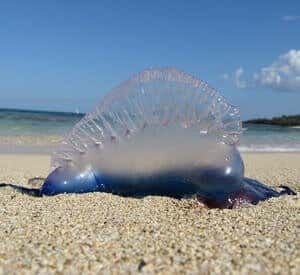
There are many home remedies for a jellyfish sting, but medical authorities are skeptical about most of them. Often, there has been little or no research on the effectiveness of a remedy. Some popular remedies may even make the pain worse (Marine Drugs, July 8, 2016). We recently wrote (below) about treating this painful problem, and an astute reader called us to task.
Vinegar Is NOT Appropriate for Box Jellyfish:
Q. In your article about treating jellyfish stings, you suggested applying vinegar. That is bad advice!
I dug into my memory and computer files for an article from the Sydney Morning Herald. A friend in Australia sent it to me in 2014, when I had just returned from a trip to the Great Barrier Reef.
We had discussed research that contradicted the use of vinegar. Aussie researchers have found that vinegar is not a good option for box jellyfish.
A. You are absolutely correct. The Australian scientists found that vinegar increased the amount of venom released by box jellyfish, Chironex fleckeri (Diving and Hyperbaric Medicine, March 2014). Vinegar is also contraindicated for stinging sea anemone, as is ammonia (Toxins, Jan. 1, 2022).
It seems that vinegar is helpful for the stings of some jellyfish species and harmful for those of others (Toxins, July 21, 2021). Consequently, swimmers shouldn’t use vinegar on jellyfish stings unless they know precisely which species has caused the sting and whether vinegar will be helpful.
One reader was lucky her remedy worked so well.
Lime Juice for a Jellyfish Sting:
Q. On the beach at Zihuatanejo, Mexico, I was standing in the warm water with my snorkel looking underwater, when a clear jellyfish attached itself to my forearm and stung me. I shook my arm violently, screamed and ran back to my husband sitting under our palapa on the beach.
A young local ran over and said to put lime juice on it. We had limes with us to put on our food, so I grabbed a cut lime and squeezed it on the jellyfish sting. The pain went away immediately! I was so glad we had a remedy right in our insulated lunch carrier!
Vinegar As First Aid:
A. Thanks for sharing this first aid trick for a jellyfish sting in Mexico. We have heard that lifeguards sometimes suggest vinegar as an antidote to such stings.
Q. Life guards at Daytona Beach use a remedy for man-o-war stings that you should know about. Spray on white vinegar, scrape the stings with the edge of a credit card to get the barbs out, then run hot water over the area. That’s the 1-2-3 treatment.
A. Thanks for sharing this approach. Although urine on a sting is a common home remedy for jellyfish stings, it does not work. Vinegar and/or hot water are preferred.
Because lime juice is acidic, it may be acting on the same principle as vinegar. Wash the juice off well before you expose your skin to the sun, though. It can lead to a surprisingly severe sunburn.
Hot Water Eases Pain of Jellyfish Sting:
Hot water is often recommended. It should be hot enough to be painful but not so hot that it will burn the skin (110 to 113 F).
Q. Years ago, my three-year-old tripped and fell on a man o’ war jellyfish while we were at the beach. She was writhing in pain.
I immediately tried a paste of meat tenderizer, but it did not help. So I took her to the nearest hospital. In the emergency room, they put her into a hot-water bath, and before I knew it, she was happy as a lark, pain free and playing in the water.
A. Although Portuguese man o’ war look like jellyfish, they are technically classified as Physalia. Their stings cause intense pain and can lead to systemic effects, including headache, abdominal cramps, vomiting and diarrhea.
Researchers tested first aid protocols and discovered that rinsing the site with undiluted vinegar (5 percent acetic acid) was helpful (Toxins, May 2017). Alcohol, urine, baking soda and shaving cream, which have all been used as home remedies, appear to be counterproductive. Hot water, on the other hand, helps relieve the pain because heat inactivates key venom compounds (Toxins, April 2016). The water should not be so hot that it would lead to a burn.
The Official Word on Vinegar:
Both the American Red Cross and the American Heart Association suggest that certain jellyfish stings should be washed with vinegar for at least 30 seconds. This inactivates the venom of Olindias sambaquiensis and Physalia physalis (Portuguese man-of-war) species (Circulation, Nov. 2, 2010, Suppl. 3). In the case of box jellyfish, vinegar is probably counterproductive.
Citations
- Montgomery L et al, "To pee, or not to pee: A review on envenomation and treatment in European jellyfish species." Marine Drugs, July 8, 2016. DOI: 10.3390/md14070127
- Welfare P et al, "An in-vitro examination of the effect of vinegar on discharged nematocysts of Chironex fleckeri." Diving and Hyperbaric Medicine, March 2014.
- Ballesteros A et al, "Trial assay for safe first-aid protocol for the stinging sea anemone Anemonia viridis (Cnidaria: Anthozoa) and a severe toxic reaction." Toxins, Jan. 1, 2022. DOI: 10.3390/toxins14010027DOI: 10.3390/toxins14010027
- Ballesteros A et al, "Differing effects of vinegar on Pelagia noctiluca (Cnidaria: Scyphozoa) and Carybdea marsupialis (Cnidaria: Cubozoa) stings-implications for first aid protocols." Toxins, July 21, 2021. DOI: 10.3390/toxins13080509
- Wilcox CL et al, "Assessing the efficacy of first-aid measures in Physalia sp. envenomation, using solution- and blood agarose-based models." Toxins, May 2017. doi: 10.3390/toxins9050149
- Wilcox CL & Yanagihara AA, "Heated debates: Hot-water immersion or ice packs as first aid for Cnidarian envenomations?" Toxins, April 2016. https://doi.org/10.3390/toxins8040097
- Markenson D et al, "2010 American Heart Association and American Red Cross Guidelines for First Aid." Circulation, Nov. 2, 2010, Suppl. 3. https://doi.org/10.1161/CIRCULATIONAHA.110.971150

